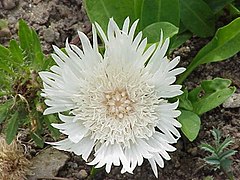Stokesia laevis
| Stokesia laevis subsp. var. | Stokes aster | |||||||||||||||||||||||||||||||||||||||||||||||||||||||
|---|---|---|---|---|---|---|---|---|---|---|---|---|---|---|---|---|---|---|---|---|---|---|---|---|---|---|---|---|---|---|---|---|---|---|---|---|---|---|---|---|---|---|---|---|---|---|---|---|---|---|---|---|---|---|---|---|

|
|
| ||||||||||||||||||||||||||||||||||||||||||||||||||||||
| ||||||||||||||||||||||||||||||||||||||||||||||||||||||||
Stokesia laevis is a species of flowering plant native to southeastern North America, the only species in the genus Stokesia. It is in the daisy family. The flowers appear in the summer and are purple (sometimes blue, pale purple, or even white).[1] The plant is cultivated and several cultivars are available.[2] It is sometimes known as Cornflower aster or Stokes' aster.
Like a few other plants (such as some species of Vernonia), it contains vernolic acid, a vegetable oil with commercial applications.[3]
| Standard Cyclopedia of Horticulture |
|---|
|
Stokesia (Jonathan Stokes, M.D., 1755-1831 English botanist). Compositae. Stokes' Aster is one of the choicest and most distinct of American hardy perennial herbs, although little planted. Heads many-fld.; marginal fls. much larger, deeply 5-cut: involucre subglobose; outer leafy, the inner with foliaceous, pectinately spinulose-ciliate, spreading appendages; receptacle fleshy, flat, and naked: achene 3-4-angled, smooth: pappus of 4-5 thread-like, deciduous scales. The species is a blue-fld. plant about a foot high which at first glance has points in common with China asters, centaureas, and chicory. The heads are 3 or 4 in. across in cult. The marginal row of fls. is composed of about 15 ray-like corollas, which have a very short tube at the base and are much broadened at the apex and cut into 5 long, narrow strips. The plant is hardy as far north as Rochester, New York, and Boston, Massachusetts. Probably many persons have been deterred from trying it because it is native to South Carolina and Georgia, and because it is considered a greenhouse subject in some standard works on gardening. The fact that it is found wild in wet pine-barrens is also deceptive, for the roots, as Woolson and Keller testify, will decay if water stands on the soil in winter. Moreover, the plant has been praised by Meehan for its drought-resisting qualities. Stokes' aster should be planted in a well-drained sandy loam, not in cold and heavy clay. It blooms from August until hard frost. According to Chapman, the heads of wild specimens are only an inch across, but the size of heads in cultivated plants is stated by many horticultural experts to be 3 to 4 inches across. The heads are frequently used for cut-flowers. In the wild the heads are few in a cluster or solitary; in cultivation a good branch sometimes bears as many as nine heads. No double form seems to have appeared but a white-flowered form is now on the market.
|
| Standard Cyclopedia of Horticulture |
|---|
|
Stokesia laevis, Hill (S. cyanea, L'Her.). Much-branched, hardy perennial herb, 1-2 ft. high: branches often purplish, sometimes hairy when young: lvs. lanceolate; radical ones entire, tapering at the base into long, flattened stalks; cauline lvs. gradually becoming sessile, the uppermost with a few teeth near the base and half-clasping: fls. blue or purplish blue, 3-4 in. across. Aug.-Oct. S. C., Ga., to La. Var. alba, Hort., has white fls. Var. praecox, Hort., is a lavender-fld. sort.CH
|
Cultivation
Propagation
Pests and diseases
Varieties
Gallery
References
- ↑ 28. Stokesia L’Héritier, Flora of North America
- ↑ United States Patent PP10660, published October 27, 1998
- ↑ Template:Citation
External links
- w:Stokesia laevis. Some of the material on this page may be from Wikipedia, under the Creative Commons license.
- Stokesia laevis QR Code (Size 50, 100, 200, 500)


